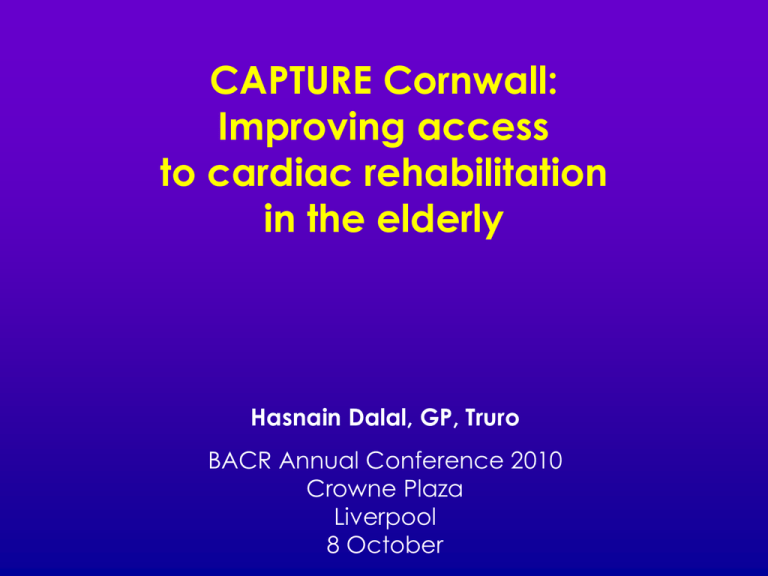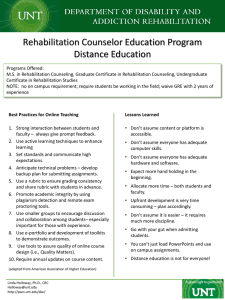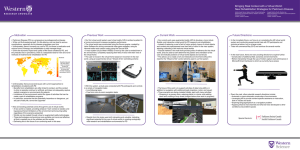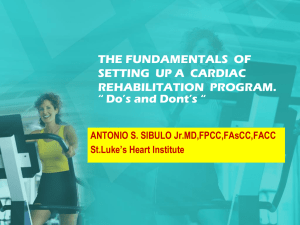
CAPTURE Cornwall:
Improving access
to cardiac rehabilitation
in the elderly
Hasnain Dalal, GP, Truro
BACR Annual Conference 2010
Crowne Plaza
Liverpool
8 October
CAPTURE Cornwall Core Team
• Teresa Jago, Physiotherapist
• Gill Payne, Cardiac Rehabilitation Nurse
• Cathy Proctor, Cardiac Rehabilitation Liaison Nurse
• Jenny Wingham, Research Nurse
• Cornwall & Isles of Scilly PCT
• Royal Cornwall Hospitals Trust
• Peninsula Medical School
Death rates
from CHD
per 100,000
population
CHD=coronary heart disease.
Source: British Heart Foundation, 1997.
Increasing prevalence of CHD
• Increases between 1994
and 2005 in the >75 years :1
30
• 22.7% to 26.4% in men
• 15.9% to 18.4% in women
26.4%
20
3.7%
22.7%
18.4%
15.9%
• The over 65s are the fastest
growing subgroup of
cardiac patients
10
0
Men
Women
2.5%
Why CAPTURE?
• Patients aged >75 years form increasing part of CR service
workload
• Conventional CR programmes may not always be
appropriate to their needs
• Systematic reviews indicate that older patients benefit from
CR at least as much as younger patients
CAPTURE Cornwall
CArdiac
Professionals
Together
Utilising
Rehabilitation services for the
Elderly
Drivers for CAPTURE Cornwall
• Two audits presented at annual meeting
of BACR in 2001 and 2003
• Funding from BHF and BLF in 2004
BACR=British Association for Cardiac Rehabilitation.
BHF=British Heart Foundation.
BLF=Big Lottery Fund.
First audit
Achieving NSF milestones for cardiac rehabilitation
and secondary prevention
BACR Annual Conference, 28 Sep 2001
Imperial Hotel, Blackpool
Quality improvement report
Achieving national service framework standards for
cardiac rehabilitation and secondary prevention
Hasnain M Dalal, Philip H Evans
1Dalal
HM, Evans PH. BMJ 2003;326:481–484.
Lessons learnt1
• Not all patients were
suitable for rehabilitation
• 23% unable to attend
classes or use the Heart
Manual
Heart Manual
Hospital-based
rehabilitation
35 (33%)
47 (44%)
24 (23%)
• Common reasons:
• Comorbidity associated
with advanced age
• Arthritis, heart failure and
stroke
1Dalal
HM, Evans PH. BMJ 2003;326:481–484.
Alternative
package
Second audit
• Poster presentation at BACR in 2003
• Audit of 908 patients
post-MI between 1999
and 2003
• 44% (mean age 80 years)
were not suitable
for ‘conventional’ CR
• Main reasons
for exclusion:
• Severe CHF (20%)
• Mobility problems (14%)
CHF=congestive heart failure.
CR=cardiac rehabilitation.
MI=myocardial infarction.
Not suitable
for conventional CR
Heart Manual
35%
44%
21%
Hospital-based
rehabilitation
Proportion of patients unable to access
CR is increasing
70
Heart Manual
Hospital-based CR
Not suitable
60
50
40
30
20
10
0
1999-2000
2001-2002
2003-2004
2004-2005
The NSF goal
• Every hospital should ensure:1
• >85% of patients discharged from hospital with a primary
diagnosis of acute MI should be offered cardiac rehabilitation
• At 1 year after discharge, 50% of people should be
non-smokers with BMI <30 kg/m2
BMI = body mass index.
NSF = national service framework.
1Department
of Health. NSF for CHD. London: DoH, 2000.
What is CAPTURE?
• In 2005, Central and West Cornwall PCTs secured funding to
improve access to CR in under-represented groups
• BHF/BLF provided
funding for 3 years
from November 2005
• PCT agreed to continue
funding if beneficial
outcomes demonstrated
110,000
PCTs
60,000
0
25,000
50,000
75,000
100,000
Funding (£)
• Home-based CR service for elderly patients who had
suffered heart attack or undergone CABG surgery
• After 1st year, age criteria of >75 years dropped and eligible
valve surgery patients also seen
BLF=Big Lottery Fund.
CABG=coronary arrtery bypass graft.
CAPTURE aims
• Increase access and uptake of CR services, particularly
among elderly patients who have low use of existing services
• Offer individualised support packages/programmes to
patients to increase choice
• Develop comprehensive individualised CR plans for patients
who cannot access or are not suitable for the Heart Manual
or current phase III programme
• Continue to provide seamless care across acute and
primary care services, with emphasis on long-term
secondary prevention
CAPTURE intervention
Patient’s typical management
• Band 7 physiotherapist
visits patient at home,
typically within 4 weeks
after discharge
• Assessment includes:
• Cardiovascular factors
• Heart rate
• Blood pressure
• Oximetry
• Mobility and function
• HADS, Dartmouth Co-op QoL
• Planning activity/exercise
HADS=hospital anxiety and depression scale.
QoL=quality of life.
Community Week 2–8
• Home visit by CAPTURE
care
(after
physiotherapist: 1-hour assessment
discharge)
Weeks 4–12
• Further 3 –6 home visits
• 1st follow up within 2 weeks:
• Goal setting
• Assess adherence/motivation
Weeks 7–12
• Further follow-up visits if necessary
• Secondary prevention factors
checked
• Referral to GP if appropriate
Annual follow up
• Patient encouraged to attend
nurse-led practice CHD clinic or
see GP
Key measures for improvement
• Proportion of patients seen by CAPTURE
• Proportion of patients with improvements from baseline in:
• Physical activity
• Quality of life
• Anxiety and depression
.
Results: Age and gender profile
Age group
Sex
Total
Male
Female
40–49
2
3
5
50–59
12
6
18
60–69
22
21
43
70–79
52
45
97
80
56
69
125
Total
144
144
288
*Sex not recorded for one patient.
Results: Proportion able to access CR
after CAPTURE
70
Heart Manual
Not suitable
Hospital-based CR
CAPTURE
60
50
40
30
20
10
0
2004-2005
2006-2007
2007-2008
2008-2009
Results: Women attending CR
• Although more than
one third of people
with CHD are women,
only 15% of those who attend
CR programmes are women
50
25
0
CHD
Women
• Ratio of men to women accessing
CR programmes in Cornwall estimated at 7:3
• CAPTURE demonstrated:
• more equitable proportion of women
• higher than national average proportion of women
Attend CR
Results: NSF outcomes
• Number of patients exercising for at least five 30-minute
sessions a week increased from 20.5% to 35.6%
• Increase of 15% for 73 patients with data for both assessments
• 32 patients had smoking status recorded
• One smoker at Assessment 1 had ceased smoking at
Assessment 1
• Only 14 patients had valid BMI measurement at both
assessments
• All had BMI <30 kg/m2, which did not alter at Assessment 2
Dartmouth
COOP–quality
of life score
Patients with normal score
at assessment
1
2
Change
Physical fitness
65
6 (9.2)
10 (15.4)
+6.2
Feelings
68
55 (80.9)
59 (86.8)
+5.9
Daily activities
66
45 (68.2)
53 (80.3)
+12.1
Social activities
63
34 (54.0)
43 (68.3)
+14.3
Pain
64
30 (46.9)
36 (56.3)
+9.4
Overall health
64
28 (43.8)
34 (53.1)
+9.3
Social support
64
57 (89.1)
54 (84.4)
–4.7
Quality of life
66
58 (87.9)
63 (95.5)
+7.6
Results: Dartmouth COOP–Quality of Life
• Fewer than half of patients had data at both assessments
• 65 patients completed Dartmouth COOP–Quality of Life scale
for both assessments
• Improvement in all scales except social support
(measured at Assessment 2)
• Largest improvement in social activities scale
– proportion in normal range
• Assessment 2: 68.3%
• Assessment 1: 54%
• Increase of 14%
100
75
54.0%
68.3%
50
25
0
1
.
Assessment
2
Results: Summary (Nov 2005–June 2008)
• 289 patients (61% >75 years old; no sex difference)
• Proportion of post-MI survivors not suitable for conventional
CR was reduced by 15%
• 11% more patients, mainly elderly people and women, were
able to access CR
• Improvements from baseline in:
• physical activity
• quality of life
• anxiety and depression
.
Home-based cardiac rehabilitation
is as effective as centre-based
cardiac rehabilitation among elderly
with coronary heart disease:
results from a randomised clinical trial
Bodil Oerkild, Marianne Frederiksen,
Jorgen Fischer Hansen, Lene Simonsen,
Lene Theil Skovgaard and Eva Prescott
1Oerkild
B et al. Age Ageing 2010;15 Sep:10.1093/ageing/afq122
Conclusion
• Innovative programmes such as CAPTURE can help to
improve the current low uptake of CR by:
• reaching the elderly and women who have difficulty in
accessing conventional CR
• offering a home based exercise programme and long term
follow up in the community through good links between
primary and secondary care have been key to the success of
CAPTURE
.
Our Health, Our Care, Our Say
“…aims to bring care ‘closer to home' with a series
of initiatives to improve local community based
services”
Department of Health
White Paper
2006
Next steps
• Make a business case for CAPTURE so it is commissioned by
GP consortia
• Improve CR services for people with CHF
• Bring BACR to Cornwall
• Present findings of REACH-HF!
.REACH-HF=Rehabilitation Enablement in Chronic Heart Failure.












